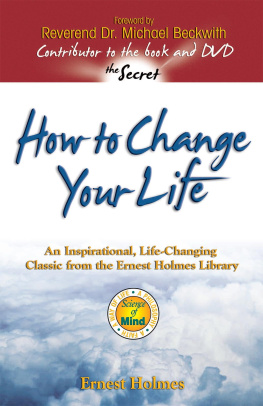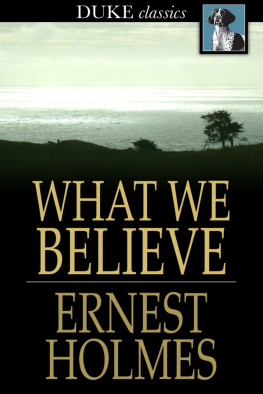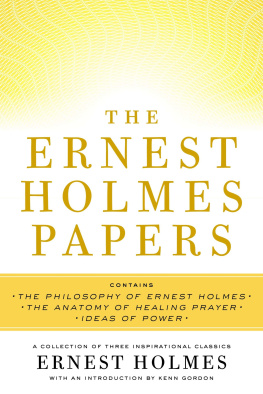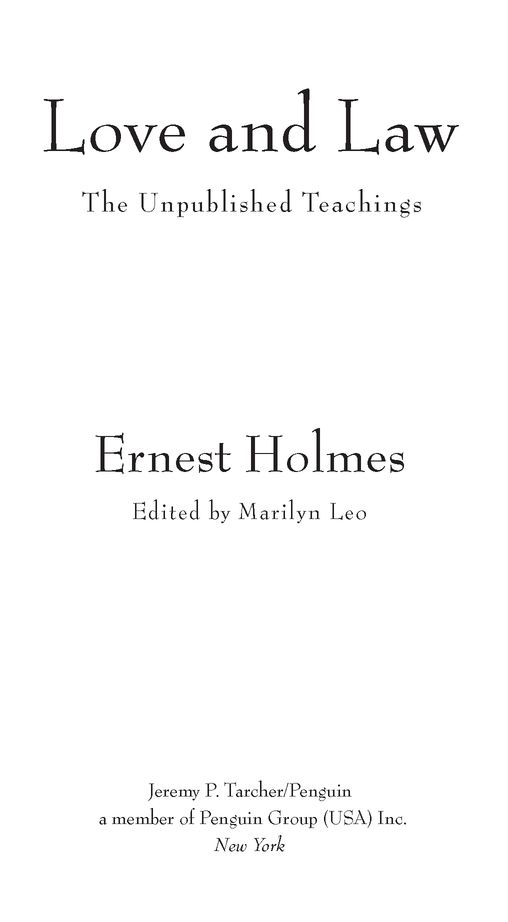Table of Contents
Also by Ernest Holmes
The Science of Mind
Creative Mind and Success
This Thing Called Life
This Thing Called You
MostTarcher/Penguin books are available at special quantity discounts for bulk purchase for sales promotions, premiums, fund-raising, and educational needs. Special books or book excerpts also can be created to fit specific needs. For details, write Penguin Group (USA) Inc. Special Markets, 375 Hudson Street, New York, NY 10014.
Jeremy P. Tarcher/Penguin
a member of
Penguin Group (USA) Inc.
375 Hudson Street
New York, NY 10014
www.penguin.com
First trade paperback edition 2004
Copyright 2001 by United Church of Religious Science
All rights reserved. This book, or parts thereof, may not
be reproduced in any form without permission.
Published simultaneously in Canada
Holmes, Ernest, 1887-1960.
Love and law : the unpublished teachings / Ernest Holmes ;
edited by Marilyn Leo.
p. cm.
ISBN : 978-1-4406-5029-1
http://us.penguingroup.com
About This Book
Yellowed and brittle, the pages of transcription by students of Ernest Holmes now, once again through this book, bring to life words to live by. There is a message of depth to show us how we may choose a life that can be more beneficial for us and the world. This book is prepared in three parts. It consists of three different series of talks given around the same time, 1918. Ernest was known to give a morning lecture, a different lecture in the afternoon, and perhaps an evening class, all in the same day.
Ernest, as he was usually addressed, never prepared his lectures with notes or manuscript. He lived in the Presence of God, and his profound ideas come to prove this. We must take into account the era of these lectures. World War I ended in November 1918, and this war is referred to in some of his lectures. Also at this time there was a major epidemic of influenza in Europe and America.
Ernest had an amazing memory for literature, poetry, and the Bible. However, many Bible quotes are not word for word. He studied the King James Version, and the verses he refers to may be found there. At times it seems he created his own words. You will also find a few slang terms of the day. The editor has, where necessary, brought gender inclusiveness to the lectures. In a few cases there were words left out by the stenographer; these additions have been made.
Throughout the years people have asked if Ernest Holmes believed and spoke the same in his early years, around 1916, as in his last, 1960. I would have to say yes and no. What he believed about our choice and how we create our own world remained the same. How he expressed his beliefs may have mellowed a bit in later years. His first book, Creative Mind, is about these beliefs in clear and concise terms. His last book, The Voice Celestial, coauthored with his brother Fenwicke Holmes, is an entirely different kind of book: a book of poetry.
Ernest was very much the mystic. In a talk he gave in 1958 in Whittier, California, he comes to a place where he believes he has seen the veil, and it is very thin.
Sometimes people have felt that Ernest spoke and emphasized the Law rather than Love. But he believed that Love points the way and the Law makes the thing possible. The thing being the desire manifested. In one of his lectures on Fundamental Metaphysics he states: You will find your word has the amount of power, the amount of intelligence you put into it, and it has creative power according to the amount of absolute conviction and the impulse of love which is behind it.
The use of the term practitioner was gleaned by Ernests early exposure to Christian Science. A practitioner is a person who practices the principles of Science of Mind. There are now people who have studied and been licensed through the organization of the United Church of Religious Science as professional practitioners. In 1920 there were only a couple of people in this position. They were Reginald Armor and Anna Holmes, Ernests mother. The practitioners and patients that Ernest is referring to throughout his talks are the people he was speaking to, not licensed practitioners.
There is no practitioner that can do anything more for you than to help you. Your final emancipation will be written by your own hand or it will never be written at all, it will be thought out by your own mind. It will govern your own consciousness as it recognizes the supremacy of mind, the infinite impulse of spirit, and your own divine birthright to use it. In other words, the final determination of your healing is up to you, in your acceptance of truth. As Jesus said: It is done unto you as you believe.
Editor
Rev. Marilyn [Armor] Leo
About the Author
Ernest Shurtleff Holmes, public speaker, religious leader, and author, was born in Lincoln, Maine, on January 21, 1887, one of nine sons of William Nelson, a farmer, and Anna Columbia (Heath) Holmes.
Ernest received his education in the rural schools of his native community, the public schools of Lincoln, Maine, and Goulds Academy, in Bethel, Maine. From 1908 to 1910 he attended the Leland Powers School of Expression, in Boston, while at the same time working in a retail store, which he continued to do for the next three years.
In 1912 he went to California, where he served as playground instructor and purchasing agent for the City of Venice. Beginning about 1915, he was asked to speak in a friends home about his beliefs and philosophy. He quickly grew in popularity and until the early 1960s he was prolific in his lectures as well as successful at publishing books. By 1916 he began lecturing in auditoriums in Los Angeles to many hundreds of people.
He and his brother Fenwicke established a home in Venice, California, for metaphysical treatment. In 1916 they also began publishing a magazine, The Uplift. In 1917 they organized the Southern California Metaphysical Institute and in 1918 established a metaphysical sanitarium in Long Beach.
During these few years Ernest maintained a lecture hall and treatment offices in Los Angeles and spoke on Sundays in the Strand Theater. In 1920, he and his brother traveled to New York, Boston, and Philadelphia, where they spoke to overflow crowds in lecture halls and theaters. Finally, in the early 1920s, Ernest sought more permanency and stability in his endeavors by confining his work primarily to one location. He then returned to Los Angeles and began to steadily expand his career, lecturing in the Biltmore and Ambassador Hotels. He established headquarters in the North Parlor of the Trinity Hotel (later known as the Embassy), conducting midweek meetings and special classes. Ernests mother and his lifelong friend Reginald Armor established offices in this location as practitioners to meet the needs of the ever-increasing number of followers.
In 1927 he founded the Institute of Religious Science and School of Philosophy, which was later changed to the Church of Religious Science and, most recently, the United Church of Religious Science. He served as dean of the school and leader of the church organization until the close of his life. Also in 1927, on October 23, Ernest was married in Los Angeles to Hazel Foster, daughter of Charles and Ann Durkee. They had no children.
Ernest had a casual form. He often wore plaid shirts and loafer shoes and was completely comfortable with whomever he was with, whether celebrities of Hollywood, university professors, or the indigent. He was at home in his surroundings. The feeling behind some of these lectures of sitting in his living room with a roaring fire is accurate. He, along with his beloved wife, Hazel, celebrated life often in their home with many friends. There was most often conversation, with Ernest asking questions of others as well as giving his own personal views about life, the universe, and how it all works.






